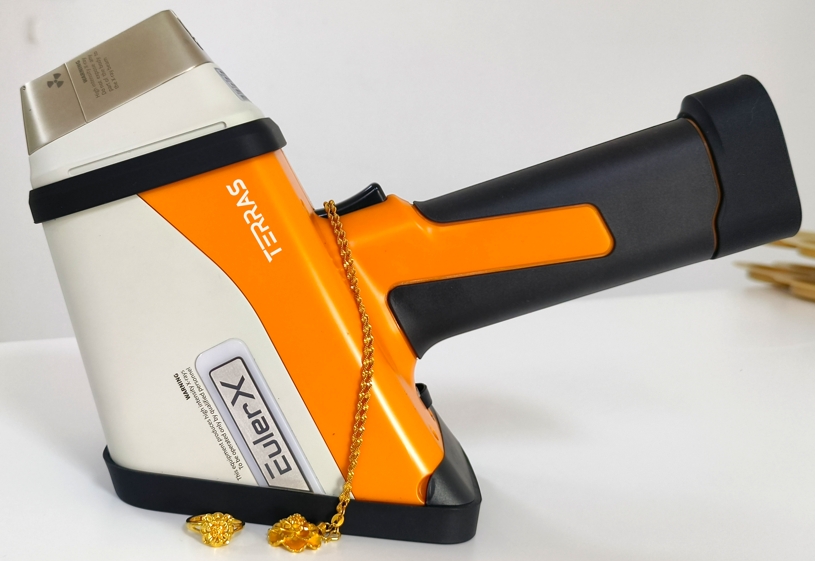
Gold and Jewelry
A high-tech enterprise focusing on the development and application of X-ray technology products, committed to becoming a leading supplier of X-ray industrial testing solutions.
How to Choose the Best Handheld XRF Analyzer for Gold Analysis
Gold is a precious metal with immense value in various industries, from mining and refining to jewelry and electronics. Accurate analysis of gold content is crucial for determining its quality and authenticity. One of the most effective tools for this purpose is the handheld X-ray fluorescence (XRF) analyzer. These devices offer a portable, non-destructive method for analyzing gold and other metals. If you're in the market for a handheld XRF analyzer for gold analysis, here's a guide to help you choose the best one for your needs.

Terras EulerX990 Handheld Precious Metal Analyzer
1. Understand Your Requirements
Before diving into the specifics of XRF analyzers, it's important to identify your specific needs. Consider the following factors:
Purpose: Are you analyzing gold in a laboratory setting, in the field, or in a production environment? The intended use will influence the type of XRF analyzer you require.
Accuracy and Precision: Depending on your application, you may need high precision and accuracy. This is particularly important for quality control and regulatory compliance.
Budget: Handheld XRF analyzers vary widely in price. Determine your budget to narrow down your options.
2. Look for Key Features
When selecting a handheld XRF analyzer for gold analysis, consider these essential features:
Detector Type: XRF analyzers use different types of detectors, such as Silicon Drift Detectors (SDDs) or High-Purity Germanium (HPGe) detectors. SDDs are common in handheld models due to their sensitivity and speed.
Elemental Range: Ensure the analyzer can accurately detect and quantify gold and other elements of interest. Some analyzers are designed specifically for precious metals, while others offer broader elemental analysis.
Calibration: Check if the device has built-in calibration standards or requires external calibration. Automatic calibration features can simplify the analysis process.
Data Storage and Connectivity: Look for models that offer ample data storage and easy connectivity options (e.g., USB, Bluetooth) for data transfer and analysis.
3. Consider Portability and Ergonomics
Handheld XRF analyzers are prized for their portability. Evaluate the following aspects:
Weight and Size: Ensure the device is comfortable to hold and carry, especially if you need to use it for extended periods.
Battery Life: Opt for a model with a long-lasting battery to avoid interruptions during fieldwork.
User Interface: A clear, intuitive interface will make the device easier to operate and interpret results.
4. Evaluate Build Quality and Durability
Given the often harsh environments in which handheld XRF analyzers are used, durability is key. Consider the following:
Construction: Look for analyzers with robust, rugged construction that can withstand rough handling and environmental conditions.
Protection: Ensure the device has adequate protection against dust, water, and other potential contaminants.
5. Assess Manufacturer Support and Warranty
Reliable support and a good warranty can make a significant difference:
Warranty: Choose a model with a comprehensive warranty to cover potential repairs or defects.
Customer Support: Opt for a manufacturer known for excellent customer support and technical assistance.
6. Read Reviews and Seek Recommendations
Before making a final decision, read reviews from other users and seek recommendations from industry experts. Reviews can provide insights into the real-world performance of the analyzer and its reliability.

Terras EulerX990 Handheld Precious Metal Analyzer
7. Test the Device
If possible, arrange for a demo or trial period to test the XRF analyzer. This hands-on experience can help you assess the device’s performance, ease of use, and suitability for your needs.
The Aurora 900 series by Terra Scientific is a groundbreaking benchtop gold analyzer that offers a fast and exceptionally precise method for determining gold content or karat, catering to quality control, pricing, and practical applications. It enables users to perform immediate, cost-effective, and completely non-destructive tests to determine gold purity and verify alloy compositions.The disadvantages of the Aurora 900 are from these aspects: the first is the algorithm,we use FP method, no need calibration. It’s test time is very fast, which only needs 10-15 seconds, also, there is no curve drift. The second is it’s design, it is compact, good looking and fashion able. The third is it’s weight, it is very light and portable, easy to move. The last one is it is easy to use, so any one can operate the analyzer without special training.
Conclusion
In conclusion, selecting the optimal handheld XRF analyzer for gold analysis requires a careful evaluation of your specific needs, including accuracy, portability, and durability. By considering key features such as detector type, elemental range, and ease of use, you can find a device that balances performance and cost. Additionally, assessing manufacturer support and seeking user reviews will further guide your decision. Investing in the right XRF analyzer will ultimately enhance your ability to perform precise and reliable gold analysis, ensuring quality and efficiency in your operations.
Join Us
Subscribe to our email list for updates & promotions.



